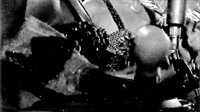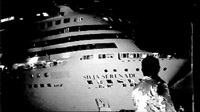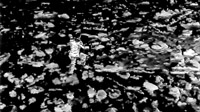|
Las Nueve Vidas (The Nine Lives), directed by Petri Kotwica, has a limited narrative scope, namely peeing. The protagonist who is a bass player in a salsa band needs to go for a pee during a job at a party. Not much of a story. According to Peter Brooks – in Reading for the Plot – a story is often structured in terms of main plot(s) and detours. He argues that the reader/viewer of the narrative is governed by the urge to know the ending of the story. We are reading for the plot. However, this urge for 'end reading' must be balanced by other energies and therefore, a story consists of 'two antagonistic instincts':
It is possible to experience Las Nueve Vidas as a kind of arabesque or detour per se. A detour into a wide range of colourful and beautifully constructed shots, travellings, etc., which we will go into more thoroughly as 'excessive' elements of the film. This detour, however, can also be regarded as a story in itself which involves essential elements of human life. A story which is structured like a typical 'Bildungsroman' with a dramatic curve of escalating conflict between obstruction and progress: A man needs to pee. He goes through much trouble fulfilling this need. Having fulfilled it, he is a completely different person. Thus, the film can simultaneously be seen as an existential story of human life and as a small excessive detour, and it is this double quality which creates its subtle irony and makes it amusing. Consequently the film lends itself to two kinds of analysis. The object of this essay is to analyse Las Nueve Vidas in these two perspectives. The 'excessive detour'
She is inspired by the essay 'The Third Meaning' by Roland Barthes who argues that the materiality of images transcends the narrative structures of coherence in a film. Thus, both Barthes and Thompson claim the existence of aesthetic elements which do not participate directly in the creation of narrative or symbolic meaning. Some of the shots in Las Nueve Vidas seem longer than necessary. This is where excess begins, as excess implies a lack of narrative motivation. Thompson mentions different ways in which the materiality of the film can become excessive. For example, the visibility of an object can be prolonged some time past the point of initial recognition to induce aesthetic rather than narrative contemplation. As Thompson points out:
In Las Nueve Vidas the viewer is guided into the first scene by an interesting close shot which introduces the band and establishes the happy mood of the party going on. The close shot shows the heaving breasts of two women dressed in black and gold with red and green feathers in their hair. This shot is not a classic establishing shot and it is too long to serve narrative ends alone. The viewer gets plenty of time to notice the colours, the shape of the breasts which mirror the shape of the maracas the women are playing, the hands of a man playing a drum significantly close to the breasts, and the cylindrical microphone in front of the women. Our attention is captured and help by this stream of images, including that of the microphone, the significance of which we will explore in a wider context later.
This shot is an illustrative example of cinematic excess. The succeeding travelling introduces the bass-playing protagonist, and the rest of the band playing tambourine, quiro, keyboard, trumpet and claves; that is, a classic salsa band playing intense, erotic music. The travelling guides us through the dance hall filled with balloons and dancing people dressed in cheerful colours. They are having a good time. At this point the viewer is introduced to some of the people. The film takes time to make us interested in, for instance, a man with a strange beard dancing with a woman dressed in red, even though he is not part of the protagonist's story at all. The only connection between these two men is their being at the same place. This kind of coincidence seems to direct the camera away from the story. On the other hand, as we shall see, this is a film whose narrative evolves because of coincidences. The travelling is followed by a medium shot of the protagonist. His face expresses that he is in some kind of pain or conflict and for that reason he is unable to enjoy the hot salsa party. When the music stops the scene changes as he runs outside. His unease is explained as he desperately searches for the lavatory. But this shot also serves to distract the viewer, this time by means of creating a bizarre situation which constitutes another excessive element, namely lightly dressed people performing some kind of dance in the snow. The urge for relief makes the protagonist try to jump the queue, which makes the waiting men stare very angrily at him and tell him to wait his turn. This is the first obstacle. The second occurs when he runs to pee at a spot in the forest. Unfortunately, the place is already taken by three peeing women. The poor fellow manages to find a supposedly undisturbed place at a flag pole on the frozen sea. He is eventually able to take a leak, but a huge ferry passes by quite close to where he is standing. In a full shot the protagonist is almost squeezed between the flag pole on the right side of the frame and the ferry entering from the left. This effect is increased by the zooming of the camera. This shot shows fascinating and remarkable composition, and in this icy, white scenery the bright red colour of the flag almost draws the viewer into the shot. Its red triangle looks like an arrow, or a marker in a computer game, pointing at our protagonist.
The colour red often signifies danger, for example in traffic lights. In this shot danger is represented by both the ferry and the flag. As the ferry breaks the ice our man clings to the sinking flag. The sound of the ferry is very obtrusive and amplifies the climax of danger. In a high-angle shot we see that the ice floes on which he stands are drifting apart, spreading his legs as they do so. The next shot, a close up, is focused on one of his feet as it is sinking into the water and then caught in a fishing net. In this net he finds a fish; an example of how coincidences seem to form this narrative. The fish surely makes the protagonist happy. This is how other associations of the colour red, e.g. warm feelings and passion, recur in the film. At this point passion is namely within the reach of the protagonist as he has both taken a pee and found the fish. Furthermore, passion and the happy atmosphere are introduced in the shot as we can hear the salsa music starting again at a distance. He returns to the band, to the golden colours and happy people, as a released man. He is bringing his new companion, the fish, and it is placed on the amplifier where it moves rhythmically – it is dancing! Phallic symbolism and the essentials of human life On the ice the act of peeing is the only obligation he has to fulfil. Here nobody expects him to be the silvery cool bass player whose swaying hips match the heaving breasts around him, as he plays the expected part of a male participant in the erotic salsa atmosphere. Here he can get it done. Consequently, escaping from the dancehall means avoiding an existential conflict between personal needs and social expectations. At the centre of this conflict is his penis which is suspended between being on the one hand a sexual symbol, on the other a tool for peeing. As mentioned above, the stage is set for erotic connotations already in the beginning of the film. Phallic symbolism is introduced in the first shot as the camera starts travelling only to catch a massive vertical boom in-between female breasts. With an almost caressing movement, the camera shows the viewer the boom in its full height and keeps it in view for a rather long time. This phallic symbol introduces the central matter of the penis. Thus, the story is not only a story of being man, but of being a man, being male. Consequently the protagonist reflects the matter of being male, too. He is wearing a silver suit which literally reflects his surroundings as its metallic surface catches the surrounding light. In the warm colours and golden light of the dancehall, the suit becomes golden and reflects the hot eroticism of salsa, whereas in the winter night under the dark sky it reflects the cold gleam of ice and snow. The silver suit therefore serves to represent the protagonist as a man who has to wear the context on his body. At the same time, however, the metallic quality of the silver suit also connotes hardness. The shiny metal can be seen as an armour symbolic of masculine self-containment. Out of this self-containment the protagonist clearly radiates Elvisness. His dark hair is combed back, and he could very well be the potent male star for whom the scene is really set. Ironically, this star can only think of peeing. Such oppositions dominate the whole film, in which we encounter binary opposites such as hardness/softness, strength/ weakness and self-containment/sociality. These opposites are not only thematically important in the story of the protagonist's identity but also function aesthetically in the use of colour, material, form and pictorial composition. The dancehall, for example, is the domain of softness and mobility. Apart from the breasts mentioned above, exposure of soft skin, the vast number of inflated (pink!) balloons, feathers and dancing people and last but not least, the motion of the travelling camera convey to the viewer an organic air of movement, an almost liquid atmosphere. Outside things change and harden. We hear the creaking sound of snow under feet as soon as the protagonist leaves the dancehall. And as he moves further away snow turns to ice, a liquid so hard that you can walk on it. The marker of the longed for place to pee is the pole with the triangular red flag, a static element of a frozen setting. Having run from the woods like a hunted man, the stumbling protagonist sees this pole and his relieved 'Ahhhh' clearly tells us that he has finally found exactly what he was looking for. As would any man, he goes for something vertical and the flagpole with its red arrow points out that this is the proper place to pee on the white sheet of ice, simultaneously symbolising the potent phallus, as does the microphone in the dancehall. As marker and phallic symbol it inaugurates order and firmness, bringing an end to the hectic search for a place to pee. The minimal camera movements visualise this new-found order; as we watch the protagonist come running out of the woods, the camera is statically placed behind the flagpole, and it is only he who moves frantically. The protagonist pees and his pleasure is obvious as he turns his face upwards, groaning. But neither order, safety, privacy nor pleasure can prevail. As mentioned before, the huge ferry intrudes from the left and penetrates the frame, breaking up both ice and order. The protagonist clings to the pole, which fails to grant him safety. Stability yields to instability as the hard fundament turns liquid beneath his feet and the sheet of ice is torn to pieces. The pole ends in the depth of the water and reveals deeper truths beneath surface level. It is connected to the fishing net, in which the protagonist's foot is caught. As he struggles to disentangle himself he discovers that he is not alone in having been caught. He finds a fish in the net and frees it, too. The fish is the third phallic symbol and the net signifies the web of cultural choreography, in which the male is at risk of getting caught in a static, self-containing position. Consequently, the freeing of the fish and the protagonist's 'self-liberation' symbolise the possibility of escaping this web. A man like the protagonist, who manages to stay calm in troubled waters and accept instability as a basic condition of life, is capable of finding a way out even when hard things are sinking. Does he abandon his second phallic companion, the pole, in favour of a third, the living fish? His subsequent cheerful jumps from ice floe to ice floe with the fish significantly protruding from the centre of his body clearly establishes a firm link between the fish and the matter of the penis, but this time the phallus is alive – and well!
As in the case of the protagonist, the silvery skin of the fish looks metallic, but it is not stiff. The fish knows how to dance, and it is capable of living unpredictability in an unpredictable world; it survives removal from its 'proper' element. It survives displacement. With such a companion the protagonist is capable of taking part in unforeseeable changes of contexts as a person who can be both hard and soft, strong and weak. He can live with the fact that we probably do not just live one life since it changes with changing contexts. As the title of the film suggests, we may actually live nine. And most importantly, he is able to enjoy company and have a good time. This film describes the process of (a) man's successful search for a way to navigate in a complex cultural choreography. At the end of the film he obviously feels better than before he managed to empty his bladder and enlighten his mind. He is, however, stuck with the problem of peeing for good. He will have to detour again and again and again. Peeing is an essential condition of human life, and it is a condition which adds still new elements of action and progress to one's life. Las Nueve Vidas uses the finding of a proper place to pee to illustrate the achievement of existential insight, as the protagonist realises and accepts that there may be no such things as proper places and proper persons, and learns to live and enjoy this basic condition – or spice – of life. To sum up, the structure of the opening shot of the film serves to introduce the viewer to conflict. Conflict and tension escalate during the course of the film as the protagonist meets new obstacles, eventually to overcome them in the happy end of the story. The protagonist returns a different man who is able to flirt and twinkle. As in a 'Bildungsroman' an educational process has taken place, but not all elements in Las Nueve Vidas serve this narrative structure. Some are excessive and aim rather to enrich classic narration, creating an aesthetic and pleasant expression of human feelings. Symbols play a vital part in Las Nueve Vidas, and we have delved into some of them, disregarding the fact that the fish could be seen as a warning against over-interpretation. A scene from Peter Greenaway's film, Drowning By Numbers, enters our minds. In this scene the three main characters Cissy, Cissy and Cissy are walking along the seashore, engaged in a bizarre discussion. Suddenly they are interrupted as they find several (red) herrings, of which some are numbered. The viewer searches for some deeper meaning, but in doing so he or she almost drowns in the effort. The same could, perhaps, happen to the viewer of Las Nueve Vidas, if he or she takes the matter of interpretation too seriously. Bibliography Brooks, Peter. Reading for the Plot - Design and Intention in Narrative. London: Harvard University, 1992. Thompson, Kristin. 'The Concept of Cinematic Excess' in Narrative, Apparatus, Ideology. Ed. by Rosen, Philip. New York: Columbia University Press, 1986. | ||
|


